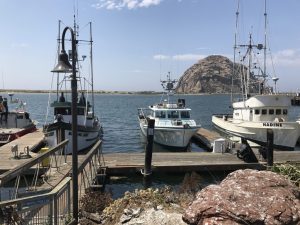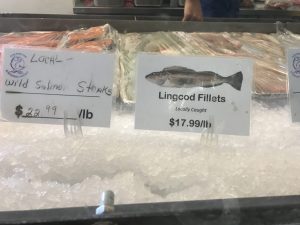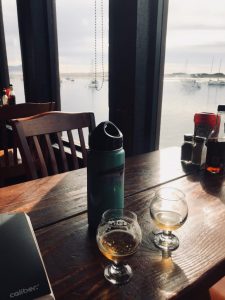
I took my last fieldwork trip to Morro Bay several months ago. As much as I’d love to go back today, I completed my last interview and now need to focus on analyzing data. For those of you who haven’t visited, Morro Bay is an incredibly charming coastal town just south of the Big Sur coast (west of San Luis Obispo). Fishing and ocean culture are strong in Morro Bay. On one side of the harbor is a memorial recognizing all of the fishermen present and past that risk dangerous marine conditions every day. The entire main drag of town is a working waterfront – boats coming and going, gear being fixed, fish changing hands. Hidden in plain sight among fish businesses is a bronze statue remembering a well-loved boat mechanic who passed away several years ago. When I ask for directions in Morro Bay, locals without exception use landmarks in the ocean or at the port as guidance. The number of pickups with buoys, traps, and other boat equipment hint at the town’s reliance on fishing and other ocean-related industries.

If it’s not clear from the paragraph above, I love Morro Bay. I’ve enjoyed every visit, and have learned an incredible amount from fishermen who have talked with me over the past year. And Morro Bay is just one of the vibrant, coastal fishing communities that we still have in California. My work on the nearshore fishery focuses on the connections among aspects of the kelp forest fish assemblage and nearshore marine ecosystem, the people and communities who make up the fishery, and the institutions governing the system. I use the Ostrom social-ecological systems framework (a way to think about connections between human and non-human aspects of a common pool natural resource system) to better understand these connections among fishermen, fishing operations, markets, and nearshore fishes. I use a mixed methods approach, combining information from interviews with fishermen and fish buyers, fishery-dependent landings data (i.e. the type, location and number of fish landed by fishermen each day), and long-term ecological monitoring data (i.e. the number and species of fish in the kelp forest, counted by SCUBA divers) to shed light on relationships and feedbacks in the nearshore fishery system.
This has been academically challenging research as I grapple with ways to combine quantitative and qualitative methods, directly compare social and ecological data collected at vastly different scales and with different approaches, and make meaningful conclusions about the ways that kelp forests influence people and vice versa. It is also incredibly exciting research in that I have gotten the chance to work with a wide range of people (academics from both natural and social sciences, fishery managers, fishermen, fish buyers), integrate different ways of knowing into my research, and generate a product that is directly relevant to the management of the nearshore fishery, in Morro Bay and across the central coast.
The research thus far has likely generated more questions than answers about the nearshore fishery, and I am sincerely excited to continue my study of the small-scale nearshore fishery and its role and relevance in the coastal fishing communities of California that I value so much.
